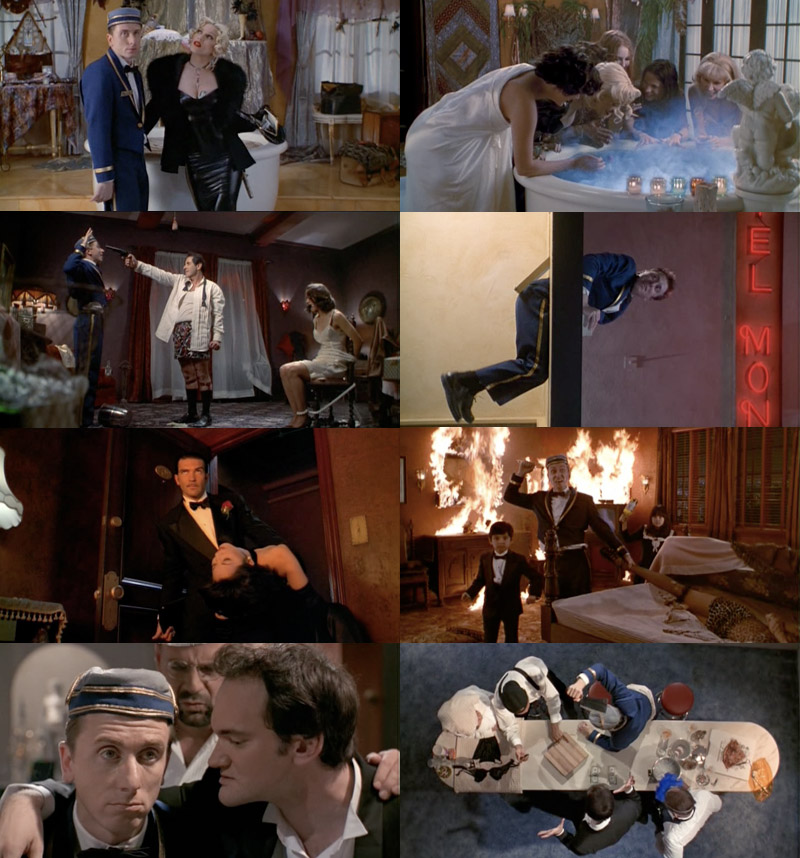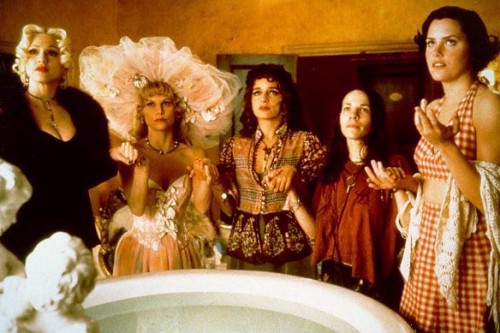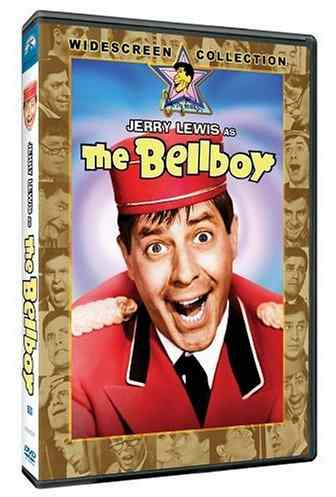From the Chicago Reader (January 19, 1996). — J.R.
Four Rooms
no stars
Directed and written by Allison Anders, Alexandre Rockwell, Robert Rodriguez, and Quentin Tarantino
With Tim Roth, Sammi Davis, Lili Taylor, Valeria Golino, Madonna, Ione Skye, Jennifer Beals, David Proval, Antonio Banderas, Lana McKissack, Danny Verduzco, Bruce Willis, Paul Calderon, and Tarantino.
Fair is fair. Though I’m calling Four Rooms worthless — an opinion that’s uncontroversial — it’s a better picture than, for example, To Wong Foo, Thanks for Everything! Julie Newmar. In fact Four Rooms is rather interesting in spite of — or perhaps because of — its disturbing awfulness. Declaring a movie worthless usually means something beyond a strictly aesthetic evaluation; there’s something punitive and moralistic, even tribal about our disapproval and rejection. (The same sort of thing often happens when we call a movie “great”: the longtime absence of any movie for and about black women obviously has influenced the recent success of Waiting to Exhale.)
Maybe calling a movie worthless is a way of getting even. Many reviewers, myself included, were excessively dismissive of Twin Peaks: Fire Walk With Me — backlash against the media hype around David Lynch (including an appearance on the cover of Time) that built up expectations and could only lead to his immolation as a sacrificial victim. The feeding frenzy over Quentin Tarantino and the mythology of the Sundance film festival over the past year has led to a comparable backlash, though Four Rooms has none of the redeeming qualities of Lynch’s last released feature. We’ve simply been asked to swallow too much guff and too many lies. Cathy Horyn’s promo piece about actor Tim Roth in the September 1995 Vanity Fair declared: “The film is hilarious.” She added, “When Miramax screened Four Rooms in May to a test group of college students, the filmmakers concluded almost immediately that no further research was necessary. ‘I was sitting next to Harvey Weinstein,’ [producer Lawrence] Bender recalls, referring to the Miramax co-chairman, ‘and I don’t think he’s ever been to a test screening where the audience’s reaction was so decisive. Those kids just loved Tim’s performance.'” Amplifying such nonsense, word drifted back from Miramax over the next three months that the film “tested through the roof.”
Maybe. But when I saw Four Rooms in August as a member of the selection committee for the New York film festival, I thought it was terrible; I can only report that for me it tested through the basement floor. When I saw a shorter version at the Toronto film festival a month later (with all four writer-directors — Allison Anders, Alexandre Rockwell, Robert Rodriguez, and Tarantino — in attendance) it didn’t seem any better, and the even shorter theatrical-release version, which drastically reduces the Anders and Rockwell episodes, reveals no substantial improvement. But I can’t argue that the movie is devoid of relevance or that it lacks any sort of coherence. On the contrary, I think it’s a film that says and shows a lot more than it intends to.
The filmmakers — identified in press materials as “four friends who are considered standard-bearers of the American independent filmmaking movement” — met four years ago when they traveled the same film-fest circuit. Anders’s Gas Food Lodging, Rockwell’s In the Soup, and Tarantino’s Reservoir Dogs were all shown at the Sundance film festival in 1992; Rodriguez’s El mariachi appeared at the Toronto film festival the following September. Rockwell proposed the idea for Four Rooms, a feature made up of four comic sketches set in a hotel on New Year’s Eve, with each filmmaker given a separate room and sketch. (Initially Hollywood’s fashionable Chateau Marmont was supposed to be the hotel.) The idea may have been to celebrate American independent filmmaking, but given the Sundance myth of instant fame and Hollywood moolah, the result is much closer to an illustration of just how obnoxious some people can be when they have studio money at their disposal. Most of the rooms are patently unreal, suggesting a Hollywood set designer’s notion of an antiquated whorehouse complete with wine red walls and musty, old-fashioned furnishings. The rooms don’t remotely jibe with the seedy front desk or the lavish bankrolls of the guests. And Tarantino’s episode is set in a penthouse suite lined with statuary that seems to belong to a different establishment entirely.
Anders’s episode — variously known in its separate incarnations as “The Missing Ingredient” and “Strange Brew” — is the gentlest and the slackest in direction. At least it shows off several enjoyable actresses (including Sammi Davis, Valeria Golino, Madonna, Ione Skye, and Lili Taylor) in the roles of witches, two of them topless for the occasion. Rockwell’s “The Wrong Man,” the most unpleasant sketch, has to do with the screaming matches between a manic husband (David Proval), his bound and gagged wife (Jennifer Beals), and Roth as the hysterical bellhop, Ted, whom they enlist in their obscure fun and games; the biggest laugh occurs when Ted, trying to escape through the bathroom window, gets vomited on by a character played by Lawrence Bender, the film’s producer, from the window on the floor above. Rodriguez’s “The Misbehavers,” the most disciplined segment, is mainly devoted to the mischief of a little boy in a tuxedo and his comparably attired sister when their parents leave for a party and pay Ted $500 to baby-sit. And in Tarantino’s curtain closer “The Man From Hollywood,” Ted gets paid over $1,000 to participate in a drunken bet inspired by an old Alfred Hitchcock Presents episode.
The small audience with whom I saw Four Rooms at the Fine Arts last week offered a far from decisive response, though some people seemed to be having a good time, or at least were trying to convince themselves they were. But in the final analysis, their reactions matter as little to the public as my somewhat divided reactions to Pulp Fiction did a year and a half ago. The general consensus seems to be that people have had enough.
But enough of what? Well, perhaps of the Sundance hype machine. For me Four Rooms is a succinct illustration-through-grotesque-parody of the Sundance myth, though for many others I suspect the myth is still alive and well. The latest Sundance festival began this week, and I’ll be very surprised if none of the usual “buzz” emerges from it. Variety’s Todd McCarthy recently told me that some of my remarks in the Reader about that festival misrepresent it, and maybe he’s right; as a nonparticipant, I can only judge the sort of media foolishness it gives rise to.
That foolishness, I would argue, principally has to do with the media-induced belief that Sundance supports and promotes independent cinema — an acceptable hypothesis only if one believes that the central and natural aim of independent filmmakers is to sell out their artistic freedom to Hollywood in exchange for money and publicity. Of course it’s theoretically possible that a festival launched and controlled by a Hollywood actor, Robert Redford, that has been sponsored in part by Premiere, Entertainment Weekly, and the New York Times could be dedicated to overturning the studio stranglehold on American film culture, but somehow I doubt it. Having it both ways seems the utopian ideal being bought and sold in this particular marketplace — that the festival will come up with a Steven Soderbergh, a Kevin Smith, an Allison Anders, an Alexandre Rockwell, or a Quentin Tarantino who’ll supposedly revolutionize Hollywood rather than be devoured by it. But as Orson Welles once noted in a similar context, if you handle shit with gloves, the gloves can only get shittier; the shit doesn’t get any glovier.
One could cite several directors as better models of independent American moviemaking, starting with such familiar figures as Charlie Chaplin (who built and ran his own studio), Orson Welles and John Cassavetes (both of whom ultimately opted for marginality and freedom over fame and enslavement), and, more recently, Jim Jarmusch, who owns the negatives of most or all of his features and succeeded as an independent without the assistance of Sundance or Hollywood “advisers.” I would also cite the less obvious names of Jerry Lewis and Samuel Fuller, who forged their own idiosyncratic paths through the Hollywood studio systems of the 50s and 60s. Years ago, when a former Sundance director asked me to suggest an American filmmaker the festival could feature in a retrospective and I mentioned Lewis, he blanched and said he couldn’t even imagine proposing that name to Redford. Yet it’s Lewis who’s the eminence grise behind Ted the bellboy in Four Rooms — specifically the bellboy in Lewis’s first feature as a director, made on the cheap in Miami Beach. In the original cut of Four Rooms this allusion — made explicit by Tarantino in the final sketch — was much stronger. Here’s the original speech, delivered by Tarantino himself:
“As I was saying, Ted, when Norman thinks of bellboys, he thinks of Quadrophenia. But me, when I think of bellboys, I think of The Bellboy, with Jerry Lewis. Didja ever see The Bellboy?…You should, it’s one of Jerry’s better movies. He never says a word through the entire film. A completely silent performance. How many actors can pull that off? And he has to go to France to get respect. That says it all about America right there. The minute Jerry Lewis dies, every paper in this fuckin’ country gonna write articles calling the man a genius. It’s not right. It’s not right and it’s not fair. But why should that surprise anybody? When has America ever been fair? We might be right every once in a while, but we’re very rarely fair.”
This was the feistiest, most courageous speech in the whole movie, and perhaps the closest thing to a political declaration Tarantino has ever made. But at some point before the film reached Toronto, everything following “How many actors can pull that off?” got cut — whether by Tarantino or Miramax I don’t know. It’s a deletion worth pondering, considering the independent artistic expression Four Rooms is supposedly celebrating.
Toward the beginning of Jean-Luc Godard’s Les carabiniers (1963), an archetypal war-movie satire about all wars and all war movies, a couple of the king’s henchmen tell the two heroes that they can do anything they like in a war. “Can we steal jukeboxes?” asks one of the heroes. “Can we break old men’s glasses? Stab people in the back? Ransack houses?” “Of course,” he is told. “Can we set fire to villages? Burn women? Slaughter innocents? Inform on people? Leave restaurants without paying?” “Oui, c’est la guerre,” one henchman assures him.
In a similar fashion, Four Rooms tells us the sort of things that Hollywood big shots can do — at least according to Tarantino, who plays hotshot director Chester Rush in “The Man From Hollywood.” They can order Cristal champagne, guzzle it, and then spit or dribble it out if they feel like it, or shake it directly out of the bottle onto the carpet (as Tarantino says, “It’s fuckin’ Cristal, everything else is piss”). They can browbeat a servant, say “Shut the fuck up, bitch” to a movie star (Jennifer Beals), and drunkenly peel off several $100 bills to pay that servant to cut off someone’s little finger with a meat cleaver — thereby fulfilling the mutilation clause I’d like to imagine is written into Tarantino’s recent contracts to gratify the eager expectations set up by Reservoir Dogs. (The “nigger” clause, which would stipulate that the word be used at least once, is fulfilled in the same episode by Paul Calderon, when he speaks about a “1964 nigger red, rag-top Chevy Chevelle.”)
The way Tarantino cruelly parodies his own media persona — right down to crowing about the box-office grosses of Chester’s two most recent features — seems part and parcel of his recent campaign to impose himself as a Hollywood actor. The morbid fascination of this protracted act of auto-destruction is that it appears to be giving the media machine behind his cult — which last year alone yielded no less than three Tarantino biographies — exactly what it’s been asking for, as if to make all the flacks choke on their own hyperbole.
Tarantino’s sketch comes last — the filmmakers’ segments appear in alphabetical order — but it clarifies the meaning of the sketches that precede it. The hotel guests in the previous episodes conduct satanic rituals in their rooms and screw the bellboy; play sexual charades involving bondage and adultery while popping pills and guzzling Jack Daniel’s, then bait the bellboy with accusations and numerous synonyms for “penis”; and leave their two kids alone to fool around with sex movies, champagne, and cigarettes — not to mention a hypodermic needle and a corpse stashed inside a mattress.
These previous sketches, I hasten to add, are not about Hollywood directors, but they all seem to illustrate the same sort of entitlements that come with hitting Hollywood pay dirt, entitlements detailed at perverse and loving length. Indeed, the very first scene, preceding the four sketches, informs us that the Mon Signor Hotel — the movie’s significantly named replacement for the Chateau Marmont — is known for its links to the Hollywood big time; an old codger (Marc Lawrence) tells Ted, “I took Rin Tin Tin out for a shit, for Christ’s sake!”
If the Rodriguez sketch about the mischief-making kids is by common consensus the most bearable of the quartet, this may be in part because it’s the only episode in which the big shots leave the hotel to have a good time, thereby sparing us all the strident revelry. And the kids, the parodic replacements of their parents, become more distanced embodiments of Hollywood excess than the adults in the movie — with the result that Rodriguez has more control over his effects than his colleagues do over theirs.
The bellboy’s role might have been more telling if Steve Buscemi, the actor originally intended for the part, had played it, though I doubt it. Some of the routines in which Ted is badgered, bullied, and exploited by the guests seem directly inspired by The Bellboy and other Lewis comedies, but Lewis’s consistent sense of solidarity with people in menial jobs is pointedly missing. Roth’s arsenal of tics and grimaces and exaggerated line readings never congeals into a comprehensible character. His English accent obscures his relation to the guests in terms of class; if he’d remained mute like Lewis in The Bellboy, he might have been marginally more endurable. But the film’s linking segments are so inept that the fact that he’s substituting for a female bellhop isn’t spelled out until just before the fourth episode, when it’s too late to make any difference in establishing his character.
Despite these confusions, Ted sometimes seems the stand-in for the hapless movie spectator, while the hotel guests appear to be the inadvertent stand-ins for the Hollywood big shots we paradoxically take Anders, Rockwell, Rodriguez, and Tarantino to be by virtue of their status as “standard-bearers of the American independent filmmaking movement.” In short, given the freedom to say “anything,” all four filmmakers are reduced to making allegorical statements about the ugly side of their supposed freedom as filmmakers — the freedom to humiliate their employees as well as themselves, to blow a wad, and to behave like assholes. This clearly wasn’t their conscious intention, but given the mythological premises underlying this project from the start, these meanings seem to have risen to the surface without much prompting.
The class implications of this allegory are painfully clear: though I suspect that Rockwell’s background is more comfortable, the working-class origins of Anders, Rodriguez, and Tarantino (or at least what are perceived as his working-class origins) are central to their movies, and the myth of these filmmakers’ ascendancy derives its power from the American dream. Four Rooms is a nouveau riche celebration of that dream that hasn’t taken the trouble to rationalize its frank displays of greed and narcissism, and if most audiences and critics are recoiling from the result, it’s because it shows too much of that dream, embarrassing us all with its implications.





